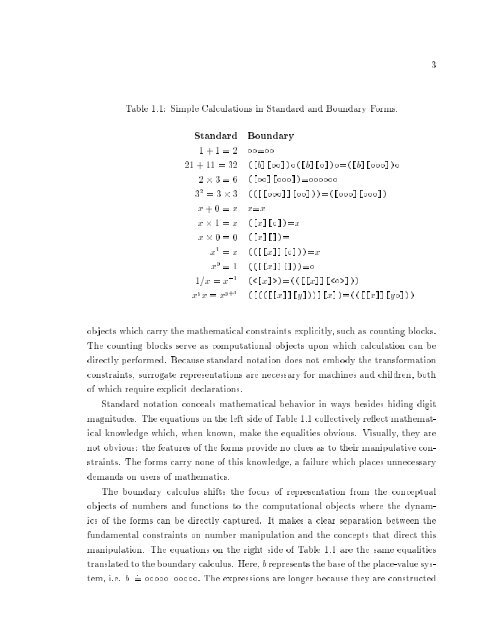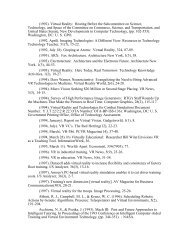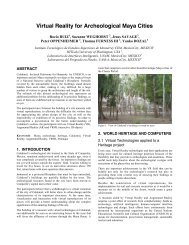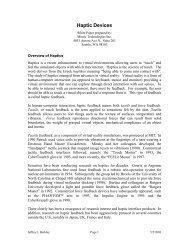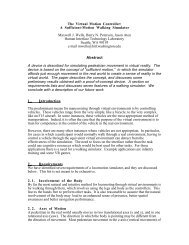A Calculus of Number Based on Spatial Forms - University of ...
A Calculus of Number Based on Spatial Forms - University of ...
A Calculus of Number Based on Spatial Forms - University of ...
You also want an ePaper? Increase the reach of your titles
YUMPU automatically turns print PDFs into web optimized ePapers that Google loves.
3<br />
Table 1.1: Simple Calculati<strong>on</strong>s in Standard and Boundary <strong>Forms</strong>.<br />
Standard Boundary<br />
1+1=2 =<br />
21 + 11 = 32 ([b][])([b][])=([b][])<br />
2 3=6 ([][])=<br />
3 2 =33 (([[]][]))=([][])<br />
x +0=x x=x<br />
x1=x ([x][])=x<br />
x 0=0 ([x][])=<br />
x 1 = x (([[x]][]))=x<br />
x 0 =1 (([[x]][]))=<br />
1=x = x ,1 ()=(([[x]][]))<br />
x y x = x y+1 ([(([[x]][y]))][x])=(([[x]][y]))<br />
objects which carry the mathematical c<strong>on</strong>straints explicitly, such as counting blocks.<br />
The counting blocks serve as computati<strong>on</strong>al objects up<strong>on</strong> which calculati<strong>on</strong> can be<br />
directly performed. Because standard notati<strong>on</strong> does not embody the transformati<strong>on</strong><br />
c<strong>on</strong>straints, surrogate representati<strong>on</strong>s are necessary for machines and children, both<br />
<str<strong>on</strong>g>of</str<strong>on</strong>g> which require explicit declarati<strong>on</strong>s.<br />
Standard notati<strong>on</strong> c<strong>on</strong>ceals mathematical behavior in ways besides hiding digit<br />
magnitudes. The equati<strong>on</strong>s <strong>on</strong> the left side <str<strong>on</strong>g>of</str<strong>on</strong>g> Table 1.1 collectively reect mathematical<br />
knowledge which, when known, make the equalities obvious. Visually, they are<br />
not obvious: the features <str<strong>on</strong>g>of</str<strong>on</strong>g> the forms provide no clues as to their manipulative c<strong>on</strong>straints.<br />
The forms carry n<strong>on</strong>e <str<strong>on</strong>g>of</str<strong>on</strong>g> this knowledge, a failure which places unnecessary<br />
demands <strong>on</strong> users <str<strong>on</strong>g>of</str<strong>on</strong>g> mathematics.<br />
The boundary calculus shifts the focus <str<strong>on</strong>g>of</str<strong>on</strong>g> representati<strong>on</strong> from the c<strong>on</strong>ceptual<br />
objects <str<strong>on</strong>g>of</str<strong>on</strong>g> numbers and functi<strong>on</strong>s to the computati<strong>on</strong>al objects where the dynamics<br />
<str<strong>on</strong>g>of</str<strong>on</strong>g> the forms can be directly captured. It makes a clear separati<strong>on</strong> between the<br />
fundamental c<strong>on</strong>straints <strong>on</strong> number manipulati<strong>on</strong> and the c<strong>on</strong>cepts that direct this<br />
manipulati<strong>on</strong>. The equati<strong>on</strong>s <strong>on</strong> the right side <str<strong>on</strong>g>of</str<strong>on</strong>g> Table 1.1 are the same equalities<br />
translated to the boundary calculus. Here, b represents the base <str<strong>on</strong>g>of</str<strong>on</strong>g> the place-value system,<br />
i.e. b = : : The expressi<strong>on</strong>s are l<strong>on</strong>ger because they are c<strong>on</strong>structed


